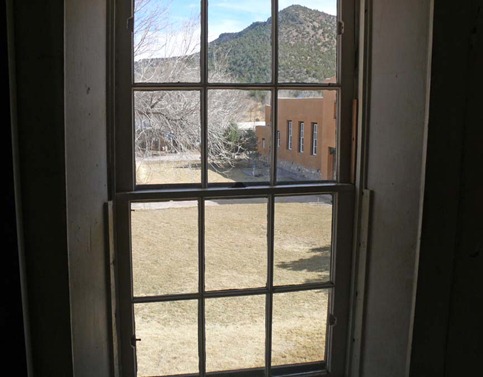 We were looking for someplace to stay warm for a few weeks before heading North, and so we headed for El Paso and the Fort Bliss RV Park, one of the best military parks we’ve stayed at (see our review here).
We were looking for someplace to stay warm for a few weeks before heading North, and so we headed for El Paso and the Fort Bliss RV Park, one of the best military parks we’ve stayed at (see our review here). 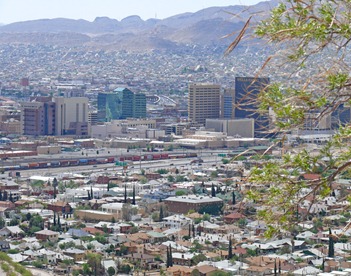 We’ve visited El Paso since the early 70s, when it was a medium-sized, friendly city with interesting shopping opportunities across the border in Juarez. All that has changed, of course, as El Paso has grown to be the 19th largest city in the U.S. with a population of over 650,000, and Juarez has become a battleground of the drug cartels. Still, it’s a nice place to visit, and seems to be at least four cities in one. On the West side of the Franklin Mountains, there’s good shopping, with a large mall, and upscale housing in the foothills. On the east side of the mountains, Fort Bliss dominates the area; a huge and rapidly expanding Army post. Further West, miles of truck terminals and storage yards support the cross-border industries, and downtown, the retail stores display most of their signs in Spanish for the shoppers across the border.
We’ve visited El Paso since the early 70s, when it was a medium-sized, friendly city with interesting shopping opportunities across the border in Juarez. All that has changed, of course, as El Paso has grown to be the 19th largest city in the U.S. with a population of over 650,000, and Juarez has become a battleground of the drug cartels. Still, it’s a nice place to visit, and seems to be at least four cities in one. On the West side of the Franklin Mountains, there’s good shopping, with a large mall, and upscale housing in the foothills. On the east side of the mountains, Fort Bliss dominates the area; a huge and rapidly expanding Army post. Further West, miles of truck terminals and storage yards support the cross-border industries, and downtown, the retail stores display most of their signs in Spanish for the shoppers across the border. 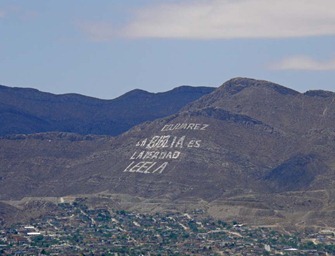 From Scenic Drive, you can take in most of El Paso and Juarez, which has an estimated population of 1.5 million, although as a result of the cartel violence (over 3000 killed in 2010), as many as 400,000 may have fled the city. As you look across the border, large white lettering is visible on a prominent mountain. Translated, it says “The Bible is the Truth – Read It” –
From Scenic Drive, you can take in most of El Paso and Juarez, which has an estimated population of 1.5 million, although as a result of the cartel violence (over 3000 killed in 2010), as many as 400,000 may have fled the city. As you look across the border, large white lettering is visible on a prominent mountain. Translated, it says “The Bible is the Truth – Read It” – 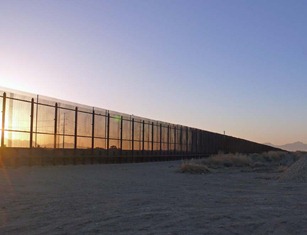 which apparently isn’t being done by enough people there. It’s sad to see how the border has turned into what looks like a war zone – the fence, guarded by Border Patrol agents, is a visible reminder of the problems of illegal immigration in the area.
which apparently isn’t being done by enough people there. It’s sad to see how the border has turned into what looks like a war zone – the fence, guarded by Border Patrol agents, is a visible reminder of the problems of illegal immigration in the area.
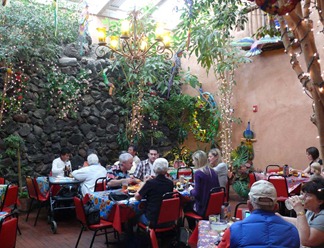 Just up the road from El Paso is Las Cruces, home of one of our favorite restaurants, La Posta de Mesilla. It’s always a must-visit when we’re in the area, Brenda for the Chile Rellenos, and for me, the pancake-style Enchiladas with an egg on top. It’s amazing how much better enchiladas are when stacked….and the egg……ahhhhhh! I’ve been visiting and ordering the same thing since 1967, and have never been disappointed.
Just up the road from El Paso is Las Cruces, home of one of our favorite restaurants, La Posta de Mesilla. It’s always a must-visit when we’re in the area, Brenda for the Chile Rellenos, and for me, the pancake-style Enchiladas with an egg on top. It’s amazing how much better enchiladas are when stacked….and the egg……ahhhhhh! I’ve been visiting and ordering the same thing since 1967, and have never been disappointed.
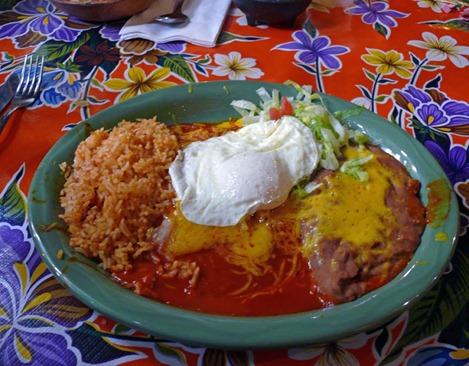 From El Paso, we drove 30 miles to the Northeast to explore Hueco Tanks State Park, an interesting area of rocks and pictographs. We were surprised by the entry procedures; after filling out a lengthy registration form, we were given a pass and told to go directly to the interpretive center for a briefing. There, a friendly park ranger had us view a 20-minute video on pictographs an the need to preserve them, then showed us on a map where we could and couldn’t go.
From El Paso, we drove 30 miles to the Northeast to explore Hueco Tanks State Park, an interesting area of rocks and pictographs. We were surprised by the entry procedures; after filling out a lengthy registration form, we were given a pass and told to go directly to the interpretive center for a briefing. There, a friendly park ranger had us view a 20-minute video on pictographs an the need to preserve them, then showed us on a map where we could and couldn’t go. 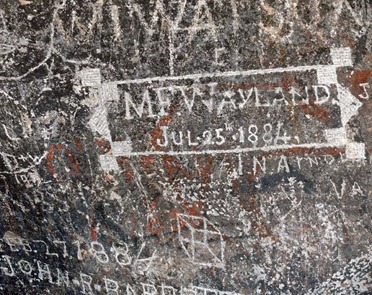 It seemed a bit unnecessary until we viewed the first pictograph site, and saw how graffiti had covered most of the original artwork. And not just recent graffiti, but even from the 1880s. In this picture, the red paint is the original native American pictograph, almost completely destroyed by the pioneer graffiti.
It seemed a bit unnecessary until we viewed the first pictograph site, and saw how graffiti had covered most of the original artwork. And not just recent graffiti, but even from the 1880s. In this picture, the red paint is the original native American pictograph, almost completely destroyed by the pioneer graffiti.
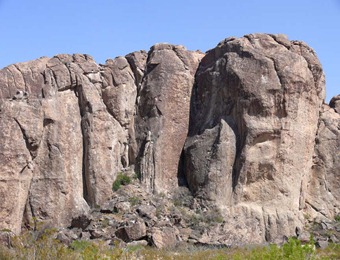 In another area of the park, we saw a red spot on the huge rocks along the road. Looking through the binoculars, it turned out to be a climber, dressed only in shorts, halfway up the sheer rock wall. I’m sure there’s a motivation behind why some someone would want to do this, but thankfully I don’t have it.
In another area of the park, we saw a red spot on the huge rocks along the road. Looking through the binoculars, it turned out to be a climber, dressed only in shorts, halfway up the sheer rock wall. I’m sure there’s a motivation behind why some someone would want to do this, but thankfully I don’t have it.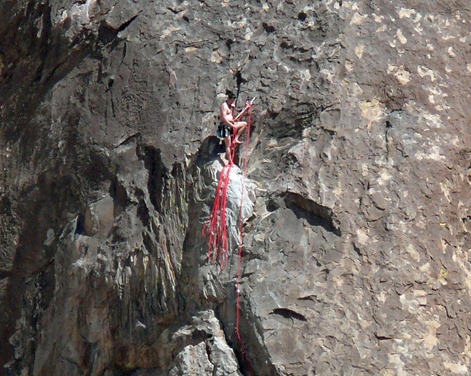 That’s it for this post; we’ll be headed to South Dakota soon – we’ll let you know how we’re doing, check back with us!
That’s it for this post; we’ll be headed to South Dakota soon – we’ll let you know how we’re doing, check back with us!
We’re still meandering around New Mexico, biding our time before we can head north for the summer. We spent some time in the Albuquerque area, and were curious about a place that was listed as one of the area’s “top ten” places to visit by Trip Advisor. So, off we went to the Tinkertown Museum, a quirky, one-of-a kind memorial to one man’s passion for carving, circus, and well…..stuff.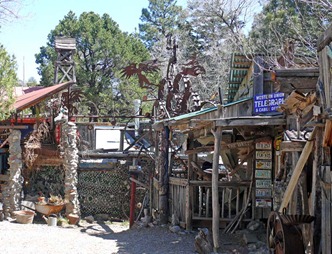 It took Ross Ward over 40 years to assemble this museum, a hodge-podge of miniature carvings, circus memorabilia, and interesting odds and ends. It’s difficult to describe – but we had a great time, and were amazed at the detail in his carvings and the patience it must have taken. Walking through the museum and surrounding buildings gives you a case of “sensory overload” – every nook and cranny is filled with a sign, carving, exhibit, design……it’s quite a place.
It took Ross Ward over 40 years to assemble this museum, a hodge-podge of miniature carvings, circus memorabilia, and interesting odds and ends. It’s difficult to describe – but we had a great time, and were amazed at the detail in his carvings and the patience it must have taken. Walking through the museum and surrounding buildings gives you a case of “sensory overload” – every nook and cranny is filled with a sign, carving, exhibit, design……it’s quite a place. 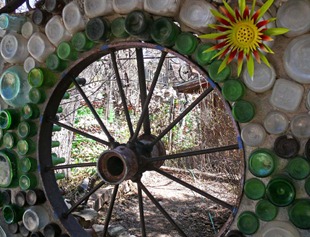 It’s also a sad story of how an immensely talented man was diagnosed with Alzheimer’s disease at an early age. We had a great visit with his wife, a delightful lady, who helped explain where many of the items in the museum came from. If you like to visit unusual places, this is a place to see!
It’s also a sad story of how an immensely talented man was diagnosed with Alzheimer’s disease at an early age. We had a great visit with his wife, a delightful lady, who helped explain where many of the items in the museum came from. If you like to visit unusual places, this is a place to see! 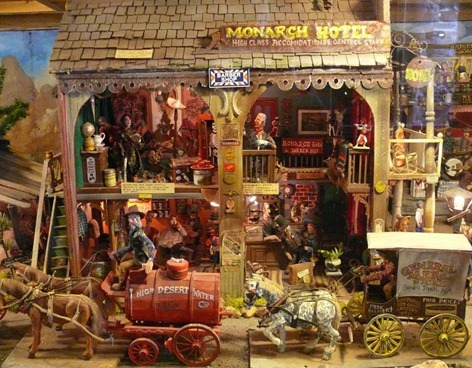
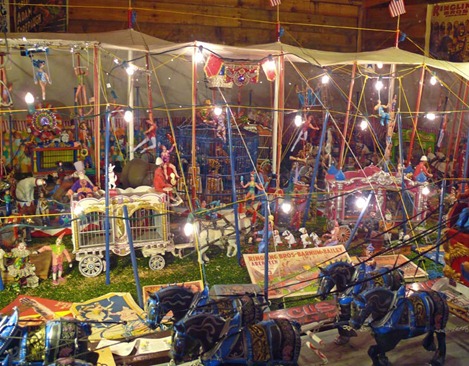 From Albuquerque, we traveled down I-25 to spend a few days at Caballo Lake RV Park, a great little park next to the lake and just down the road from Truth or Consequences. And yes, that’s really the name of the town, changed from it’s original name of Hot Springs as part of a publicity stunt for a radio show.
From Albuquerque, we traveled down I-25 to spend a few days at Caballo Lake RV Park, a great little park next to the lake and just down the road from Truth or Consequences. And yes, that’s really the name of the town, changed from it’s original name of Hot Springs as part of a publicity stunt for a radio show. 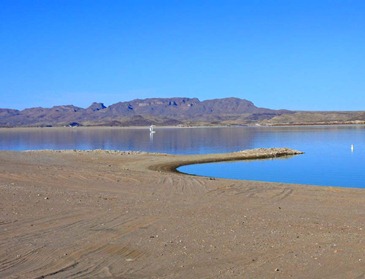 T or C, as it’s more easily known, is next to Elephant Butte Lake, the state’s largest reservoir that appears to be shrinking rapidly. The town seems to consist largely of RV and boat storage lots – literally miles and miles of dusty, chain-link fenced lots full of cheap trailers and old boats. It’s not exactly a picturesque place, especially at this time of year, and we wouldn’t want to be here in the heat of summer.
One of the great things about the Southwest is the diversity of terrain – if you don’t like the desert, just drive a few miles. In our case, it was just a half hour drive west into the Black Range and the town of Hillsboro, an old gold and silver mining town. Once a thriving village of 1200, the population now stands around 235, and aside from a few galleries and a restaurant, there isn’t much to attract visitors. It does have some interesting sights as you drive around, like the ruins of the old jail and an interesting antique truck.
T or C, as it’s more easily known, is next to Elephant Butte Lake, the state’s largest reservoir that appears to be shrinking rapidly. The town seems to consist largely of RV and boat storage lots – literally miles and miles of dusty, chain-link fenced lots full of cheap trailers and old boats. It’s not exactly a picturesque place, especially at this time of year, and we wouldn’t want to be here in the heat of summer.
One of the great things about the Southwest is the diversity of terrain – if you don’t like the desert, just drive a few miles. In our case, it was just a half hour drive west into the Black Range and the town of Hillsboro, an old gold and silver mining town. Once a thriving village of 1200, the population now stands around 235, and aside from a few galleries and a restaurant, there isn’t much to attract visitors. It does have some interesting sights as you drive around, like the ruins of the old jail and an interesting antique truck.
 A few miles further up the road brought us to Kingston, another old mining town, once 7000 strong, now with only about 25 residents. It’s another interesting place with a history, and a cemetery that’s worth a visit. We don’t normally visit cemeteries, but this one intrigued us. Located on a hill outside of town, there is no discernable order to the graves; they’re scattered here and there, some with readable gravestones, many that have been eroded and faded over time.
A few miles further up the road brought us to Kingston, another old mining town, once 7000 strong, now with only about 25 residents. It’s another interesting place with a history, and a cemetery that’s worth a visit. We don’t normally visit cemeteries, but this one intrigued us. Located on a hill outside of town, there is no discernable order to the graves; they’re scattered here and there, some with readable gravestones, many that have been eroded and faded over time. 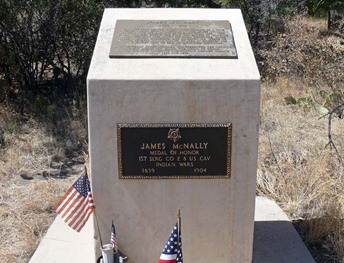 At the entrance is the grave of James McNally, a Medal of Honor recipient from the Indian Wars. Walking around the hillside, you’re struck by the random location of graves – the hard ground required that dynamite be used for burial sites, and apparently the distance between markers is because of this. There’s no grass, in fact, nothing much is green, just shades of brown broken occasionally by the placement of flowers. More than any old buildings in town, it gives a sense of the hard life people must have lived here.
At the entrance is the grave of James McNally, a Medal of Honor recipient from the Indian Wars. Walking around the hillside, you’re struck by the random location of graves – the hard ground required that dynamite be used for burial sites, and apparently the distance between markers is because of this. There’s no grass, in fact, nothing much is green, just shades of brown broken occasionally by the placement of flowers. More than any old buildings in town, it gives a sense of the hard life people must have lived here.
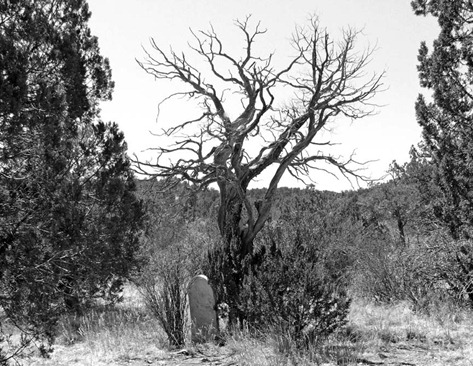
Our next stop was the highest point along the route, Emery Pass. It’s amazing that you can travel from sere desert to pine-forested mountain in such a short time. The overlook was 20 degrees cooler and dust free, stark contrast to the hot and dusty desert below. According to the sign, Lt. Emery must have been well liked – they named that pass after him even though he may not have traveled over it!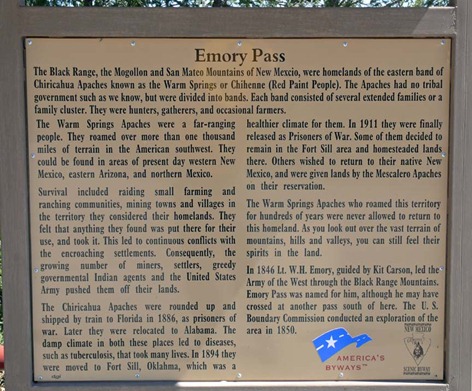 On the way back down, we stopped for a picnic lunch at a Forest Service campground, near the site of the Battle of Massacre Canyon.
On the way back down, we stopped for a picnic lunch at a Forest Service campground, near the site of the Battle of Massacre Canyon. 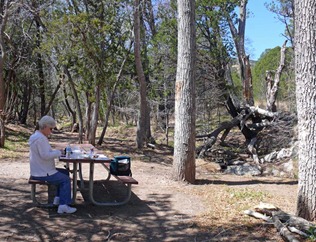 Here, a band of Apaches, let by Vittorio, nearly wiped out a company of U.S. Calvary in one of the last major Indian battles. We didn’t see any Indians, but after hearing something moving toward us through the forest, this female Javelina wandered through the area, pretty much ignoring us as she foraged for food.
Here, a band of Apaches, let by Vittorio, nearly wiped out a company of U.S. Calvary in one of the last major Indian battles. We didn’t see any Indians, but after hearing something moving toward us through the forest, this female Javelina wandered through the area, pretty much ignoring us as she foraged for food.
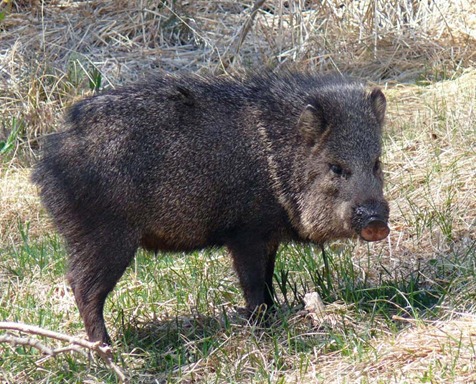 As always, we’ve enjoyed exploring the back roads and sharing our travels with you. We’ll be heading south towards El Paso next, so c’mon back and see what we’ve found!
As always, we’ve enjoyed exploring the back roads and sharing our travels with you. We’ll be heading south towards El Paso next, so c’mon back and see what we’ve found!
Traveling around Southern New Mexico reminds us of being in Northern Virginia, because just as George Washington apparently slept in every dwelling there, Billy the Kid walked every foot of ground here. The entertaining but historically inept movies “Young Guns” and “Young Guns II” brought the story, however inaccurate, to a whole new generation, and merchants throughout New Mexico responded with ways to wring a buck out of the legend. Sad, because the real story is interesting enough without all of the embellishment.
We’ll start with our visit to Silver City, where we spent a great month exploring the city and the Gila Wilderness a few years ago, and where young Billy, then known as Henry Antrim, grew up. Silver City is a great place to visit on it’s own merit, but we were also interested in seeing the town where Billy lived as a  child, went to school, and of course, committed his first crime – stealing butter. We stayed at a very nice park, Rose Valley RV Park, which was next door to the cemetery that housed the grave of Billy’s mother, Katherine (also known as Catherine). The story of where Billy was born, where his family lived before Silver City, and why he had so many different names is complicated, but can be unraveled here. We enjoyed the visit here, but the best reason to visit the area is the Gila Wilderness and the quirky atmosphere, especially during the Blues Festival.
Although as a young man Billy visited Arizona and many New Mexico locations, the most famous of his exploits took place in areas we’ve visited many times - the Sacramento Mountains area, and the towns of Lincoln,
child, went to school, and of course, committed his first crime – stealing butter. We stayed at a very nice park, Rose Valley RV Park, which was next door to the cemetery that housed the grave of Billy’s mother, Katherine (also known as Catherine). The story of where Billy was born, where his family lived before Silver City, and why he had so many different names is complicated, but can be unraveled here. We enjoyed the visit here, but the best reason to visit the area is the Gila Wilderness and the quirky atmosphere, especially during the Blues Festival.
Although as a young man Billy visited Arizona and many New Mexico locations, the most famous of his exploits took place in areas we’ve visited many times - the Sacramento Mountains area, and the towns of Lincoln, 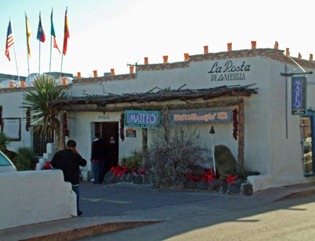 Mesilla, and Fort Sumner. In Old Mesilla, outside of Las Cruces, the plaza was visited regularly by Billy and it was here that he was convicted and sentenced to hang in Lincoln. Today, there’s a Billy the Kid gift shop dominating the corner, and just down the street is one of our favorite restaurants, La Posta, a place with great food and an interesting history. (hint – try the red enchiladas, stacked pancake-style, and topped with a fried egg!)
It’s a little more than an hour’s drive through Alamogordo and into the Sacramento Mountains from Old Mesilla – a trip that took Billy over five days to make when he as taken back to Lincoln to be hanged. On the way up the West side of the mountains to Cloudcroft you’ll pass the sign for Blazer’s Mill, where the gunfight took place that ended up with Billy’s murder conviction. There’s nothing here today but the sign, but when you travel from the site to Lincoln as Billy did, you have to marvel at the distances covered in the days of riding on horseback.
But if you’re a Billy the Kid buff, the place to visit is Lincoln. A pretty little town in the foothills, this State Historic Site looks much the same as it must have in the days of the Lincoln County War. Although dwellings in the town are occupied, owners must keep the outside appearance historically accurate. Our first stop was the visitor center, staffed by a delightful lady who let it be known that she wasn’t too fond of the “Young Guns” portrayal of Billy.
Mesilla, and Fort Sumner. In Old Mesilla, outside of Las Cruces, the plaza was visited regularly by Billy and it was here that he was convicted and sentenced to hang in Lincoln. Today, there’s a Billy the Kid gift shop dominating the corner, and just down the street is one of our favorite restaurants, La Posta, a place with great food and an interesting history. (hint – try the red enchiladas, stacked pancake-style, and topped with a fried egg!)
It’s a little more than an hour’s drive through Alamogordo and into the Sacramento Mountains from Old Mesilla – a trip that took Billy over five days to make when he as taken back to Lincoln to be hanged. On the way up the West side of the mountains to Cloudcroft you’ll pass the sign for Blazer’s Mill, where the gunfight took place that ended up with Billy’s murder conviction. There’s nothing here today but the sign, but when you travel from the site to Lincoln as Billy did, you have to marvel at the distances covered in the days of riding on horseback.
But if you’re a Billy the Kid buff, the place to visit is Lincoln. A pretty little town in the foothills, this State Historic Site looks much the same as it must have in the days of the Lincoln County War. Although dwellings in the town are occupied, owners must keep the outside appearance historically accurate. Our first stop was the visitor center, staffed by a delightful lady who let it be known that she wasn’t too fond of the “Young Guns” portrayal of Billy. 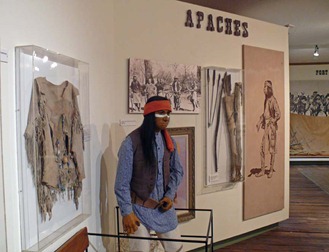 We listened as she lectured a young man who had the bad judgment to ask if Billy really killed 21 men by his 21st birthday – he left humbled but smarter (most historians agree that the number was three or four). The visitor center has a number of very well done exhibits, not only of the Lincoln County War, but also of the area’s Indian history. It’s interesting to look at the old photographs of buildings like the courthouse, and compare them to how they look today:
We listened as she lectured a young man who had the bad judgment to ask if Billy really killed 21 men by his 21st birthday – he left humbled but smarter (most historians agree that the number was three or four). The visitor center has a number of very well done exhibits, not only of the Lincoln County War, but also of the area’s Indian history. It’s interesting to look at the old photographs of buildings like the courthouse, and compare them to how they look today:
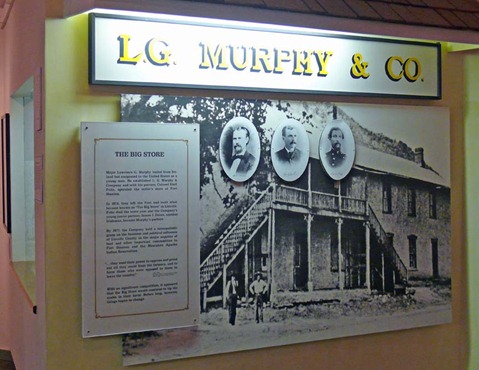
 The interior of the former store, later the courthouse, is much the same as it must have looked when Billy made his escape by killing the two men guarding him. The wall at the bottom of the stairway has what is supposedly the hole (enlarged over time by inquisitive fingers) made by Billy’s bullets.
The interior of the former store, later the courthouse, is much the same as it must have looked when Billy made his escape by killing the two men guarding him. The wall at the bottom of the stairway has what is supposedly the hole (enlarged over time by inquisitive fingers) made by Billy’s bullets. 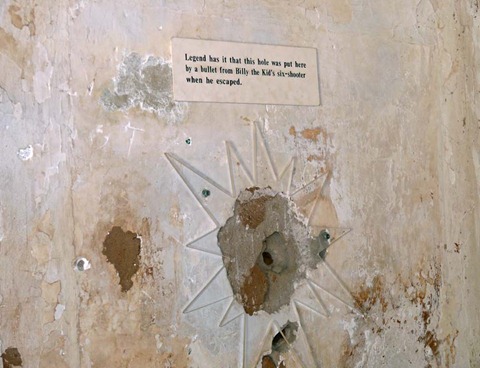 On the second floor, you can stand at the window (left side of the building pictured above, nearest the street) and look out just as Billy must have before shooting and killing the second deputy.
After his escape, Billy retreated to Fort Sumner, one of his favorite places, where he was killed at the age of 21 by Sherriff Pat Garret and buried in the local cemetery. Traveling to Fort Sumner, you begin to wonder how anyone made the trip on horseback – it’s a long, dry stretch to a dusty, half-deserted town. But with plenty of “Billy the Kid’s Grave!” signs.
On the second floor, you can stand at the window (left side of the building pictured above, nearest the street) and look out just as Billy must have before shooting and killing the second deputy.
After his escape, Billy retreated to Fort Sumner, one of his favorite places, where he was killed at the age of 21 by Sherriff Pat Garret and buried in the local cemetery. Traveling to Fort Sumner, you begin to wonder how anyone made the trip on horseback – it’s a long, dry stretch to a dusty, half-deserted town. But with plenty of “Billy the Kid’s Grave!” signs. 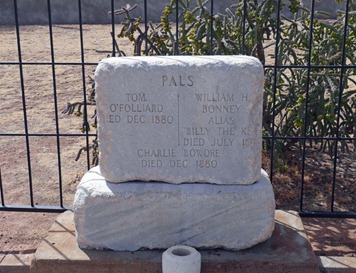 Visiting the gravesite, you’ll notice the steel fencing protecting the headstone – it’s been stolen three times, the first time in 1950 when it went missing for 26 years. The experience is a bit of a letdown when you read the fine print and learn that shortly after Billy was buried, a flood washed away all of the grave markers, so it’s a sorta/kinda guess where Billy is buried. But hey, just like the legend of Billy the Kid, you’ve got to believe……
We’ve got some more New Mexico to show you, so c’mon back and see where we’ve been!
Visiting the gravesite, you’ll notice the steel fencing protecting the headstone – it’s been stolen three times, the first time in 1950 when it went missing for 26 years. The experience is a bit of a letdown when you read the fine print and learn that shortly after Billy was buried, a flood washed away all of the grave markers, so it’s a sorta/kinda guess where Billy is buried. But hey, just like the legend of Billy the Kid, you’ve got to believe……
We’ve got some more New Mexico to show you, so c’mon back and see where we’ve been!
 We were looking for someplace to stay warm for a few weeks before heading North, and so we headed for El Paso and the Fort Bliss RV Park, one of the best military parks we’ve stayed at (see our review here).
We were looking for someplace to stay warm for a few weeks before heading North, and so we headed for El Paso and the Fort Bliss RV Park, one of the best military parks we’ve stayed at (see our review here).  We’ve visited El Paso since the early 70s, when it was a medium-sized, friendly city with interesting shopping opportunities across the border in Juarez. All that has changed, of course, as El Paso has grown to be the 19th largest city in the U.S. with a population of over 650,000, and Juarez has become a battleground of the drug cartels. Still, it’s a nice place to visit, and seems to be at least four cities in one. On the West side of the Franklin Mountains, there’s good shopping, with a large mall, and upscale housing in the foothills. On the east side of the mountains, Fort Bliss dominates the area; a huge and rapidly expanding Army post. Further West, miles of truck terminals and storage yards support the cross-border industries, and downtown, the retail stores display most of their signs in Spanish for the shoppers across the border.
We’ve visited El Paso since the early 70s, when it was a medium-sized, friendly city with interesting shopping opportunities across the border in Juarez. All that has changed, of course, as El Paso has grown to be the 19th largest city in the U.S. with a population of over 650,000, and Juarez has become a battleground of the drug cartels. Still, it’s a nice place to visit, and seems to be at least four cities in one. On the West side of the Franklin Mountains, there’s good shopping, with a large mall, and upscale housing in the foothills. On the east side of the mountains, Fort Bliss dominates the area; a huge and rapidly expanding Army post. Further West, miles of truck terminals and storage yards support the cross-border industries, and downtown, the retail stores display most of their signs in Spanish for the shoppers across the border.  From Scenic Drive, you can take in most of El Paso and Juarez, which has an estimated population of 1.5 million, although as a result of the cartel violence (over 3000 killed in 2010), as many as 400,000 may have fled the city. As you look across the border, large white lettering is visible on a prominent mountain. Translated, it says “The Bible is the Truth – Read It” –
From Scenic Drive, you can take in most of El Paso and Juarez, which has an estimated population of 1.5 million, although as a result of the cartel violence (over 3000 killed in 2010), as many as 400,000 may have fled the city. As you look across the border, large white lettering is visible on a prominent mountain. Translated, it says “The Bible is the Truth – Read It” –  which apparently isn’t being done by enough people there. It’s sad to see how the border has turned into what looks like a war zone – the fence, guarded by Border Patrol agents, is a visible reminder of the problems of illegal immigration in the area.
which apparently isn’t being done by enough people there. It’s sad to see how the border has turned into what looks like a war zone – the fence, guarded by Border Patrol agents, is a visible reminder of the problems of illegal immigration in the area. Just up the road from El Paso is Las Cruces, home of one of our favorite restaurants, La Posta de Mesilla. It’s always a must-visit when we’re in the area, Brenda for the Chile Rellenos, and for me, the pancake-style Enchiladas with an egg on top. It’s amazing how much better enchiladas are when stacked….and the egg……ahhhhhh! I’ve been visiting and ordering the same thing since 1967, and have never been disappointed.
Just up the road from El Paso is Las Cruces, home of one of our favorite restaurants, La Posta de Mesilla. It’s always a must-visit when we’re in the area, Brenda for the Chile Rellenos, and for me, the pancake-style Enchiladas with an egg on top. It’s amazing how much better enchiladas are when stacked….and the egg……ahhhhhh! I’ve been visiting and ordering the same thing since 1967, and have never been disappointed.
 It seemed a bit unnecessary until we viewed the first pictograph site, and saw how graffiti had covered most of the original artwork. And not just recent graffiti, but even from the 1880s. In this picture, the red paint is the original native American pictograph, almost completely destroyed by the pioneer graffiti.
It seemed a bit unnecessary until we viewed the first pictograph site, and saw how graffiti had covered most of the original artwork. And not just recent graffiti, but even from the 1880s. In this picture, the red paint is the original native American pictograph, almost completely destroyed by the pioneer graffiti. In another area of the park, we saw a red spot on the huge rocks along the road. Looking through the binoculars, it turned out to be a climber, dressed only in shorts, halfway up the sheer rock wall. I’m sure there’s a motivation behind why some someone would want to do this, but thankfully I don’t have it.
In another area of the park, we saw a red spot on the huge rocks along the road. Looking through the binoculars, it turned out to be a climber, dressed only in shorts, halfway up the sheer rock wall. I’m sure there’s a motivation behind why some someone would want to do this, but thankfully I don’t have it.


















